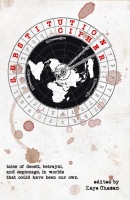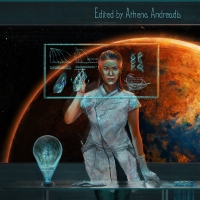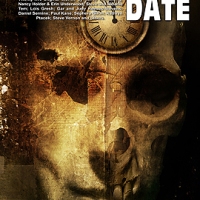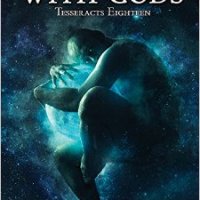Everyone knows the world is round like a ball.
Well, not everyone knows, I suppose, but the real problem is that Cristóvão Colón believes it to be a much smaller ball than most men who study this sort of thing. That’s why I—and everyone I’m sailing with—won’t be coming back.
So thinks Rodrigo de Escobedo, the narrator of my story, “So The Taino Call It,” on the eve of his departure with Columbus (Colón) to discover a western path to Asia.
Today, it’s a common misunderstanding that everyone on Earth thought the planet was flat until Columbus sailed west to reach the East. In fact, there are still folks around who believe that the Earth has edges and all this sphere business is just a big hoax.

The Earth seen from Apollo 17. Apparently faked, but only the trained eye can tell. (Photo credit: Wikipedia)
In reality (or, at least, the reality I choose to take part in), lots of people knew the Earth was round before Columbus set out to prove it (and Magellan actually did). The ancient Greeks had their suspicions, but it took Aristotle, in the fourth century BCE, to provide the most compelling evidence. Over the next several centuries, this evidence was confirmed and expanded upon by many more scholars, such as Ptolemy in Alexandria, Varāhamihira in India, Bede in England, and al-Farghānī (also known as Alfraganus, he has a crater on the moon named after him) in Persia (we’ll come back to him in a moment).
By the time Columbus arrived on the scene, it was the picky details of this spherical Earth that people were trying to wrap their heads around. How spherical?1 How big around?2 That second question is what comes into play in this story, and Columbus got it wrong in a couple of ways. The inventor of geography (one of those ancient Greeks) on the other hand, came pretty close.
Eratosthenes, the chief librarian of the Library of Alexandria, used geometry in the third century BCE to estimate what the Earth’s circumference might be. Assuming a round Earth and a sun far enough away that its rays hitting the earth at Alexandria and another Egyptian city (Syene) would be parallel, he calculated that the distance between the two cities was 7 degrees, or 1/50 of a 360-degree planet. Sadly, the work of Eratosthenes has been lost so we don’t know all the details of his calculations, specifically the exact measure of the unit (a stadion) with which he chose to measure the distance between Syene and Alexandria. It’s generally believed, though, that his figuring works out to be between 39,690 and 46,630 kilometers. Pretty close for a fellow doing most of the math in his own head (along with the fellow he purportedly hired to walk from Alexandria to Syene to measure the distance for him).
Leaping ahead 1,700 years, give or take, we come to Columbus. He did conduct some research in preparation for selling his idea of exploration, and that included reading Pierre d’Ailly‘s 1410 book of cosmography, Imago Mundi. In that work, Columbus learned of al-Farghānī’s estimation of the size of degrees of latitude and longitude. Al-Farghānī estimated that one degree of latitude or longitude should measure 56⅔ miles across. “Super!” Columbus must have thought. The great explorer ran with this number, coming up with an earthly circumference of about 30,200 kilometers.
Huh, that’s a bit different from Eratosthenes’ figure, isn’t it? Well, Columbus thought al-Farghānī was using Roman miles (1,480 meters) in his figuring. The astronomer actually used Arabic miles (about 1,830 meters).
See what happens when you don’t define the units of measure you’re working with?
This led people who thought they knew better (including King John of Portugal) to be convinced, as my scrivener/spy was, that if his ships went west, they would soon be full of corpses. No ship could carry the amount of supplies needed to reach Asia by going that way. Their crews were bound to starve to death before reaching their goal.
Another problem in Columbus’s figuring were his assumptions that Asia was a lot bigger than it really is and that Japan and China were a lot further south than they really are. His research, again, pointed him in the wrong direction. He believed Marinus of Tyre‘s estimate of the size of Eurasia (spanning 225 degrees of longitude) over that of Ptolemy (a comparatively meager 150 degrees).3
Columbus also trusted the word of the doctor and atronomer Paolo dal Pozzo Toscanelli who sent him a letter shortly before he died in 1482 which not only shared his own miscalculation of the Earth’s size but also his assumption that China and Japan lay further south than they actually do.
All of these mistakes convinced Columbus that the trip was a sure thing, and the Castilian monarchs were desperate enough for any edge in seeking trade with Asia that they were willing to go along. Lucky for Columbus that there were two giant continents lying in the way no one in Europe knew about whose islands would save his mission from disaster.
At least, as far as Columbus, his crew, and investors were concerned. But what might happen if there were a spy aboard Columbus’s flagship? What might have happened then? Well, check out Substitution Cipher on December 18 to find out!
1. The Earth turns out to be an oblate spheroid, flatter at the poles than it is at the equator.
2. 40,075.16 kilometers at that bulging equator
3. They were both wrong. The land mass of Eurasia only spans 130 degrees of longitude, 150 if you include Japan.














I think it’s fascinating how biased the history we learn in school is–everyone thought the Earth was flat (not true), the Natives welcomed the Europeans with open arms (not exactly true), etc. I read an article a few months ago about how the first Spanish contact resulted in essentially an apocalypse for the indigenous people and that’s why the English settlers found so much space, but I can’t remember where, and I don’t seem to have bookmarked it. 😛
I’ve actually read the whole book (via the e-ARC list), and I liked yours a lot! I wanted to read the next part.
If you find that article, let me know. That sounds intriguing and pretty accurate. Another myth taught is that none of the Native groups Columbus met survived. Wrong again! I found a Smithsonian article earlier last year that talked about that and was really helpful for my story.
I’m glad you liked it. Thank you! (I didn’t know about the e-ARC list) There might be a next part. The nuts and bolts of that feel quite intimidating, though.
I review books on my blog, and I got on the reviewer list a while back.
Apparently, the article I was thinking of was on Cracked (of all places…) So it’s sarcastic, but it definitely includes the idea of the US being founded on a post-apocalyptic landscape. And a bunch of other falsehoods we learned in school. http://www.cracked.com/article_19864_6-ridiculous-lies-you-believe-about-founding-america.html
I review books on my blog, too, but I haven’t gotten myself on any lists yet. Need to look into that.
Thanks for finding the link. Pretty good article. I think more people would enjoy history if we were actually taught what really happened as kids. I also love the idea of the Vikings getting their butts kicked by the Natives.
Pingback: Page not found « M. Fenn
Pingback: There’s a Little Real History in my Alternate History #5 « M. Fenn